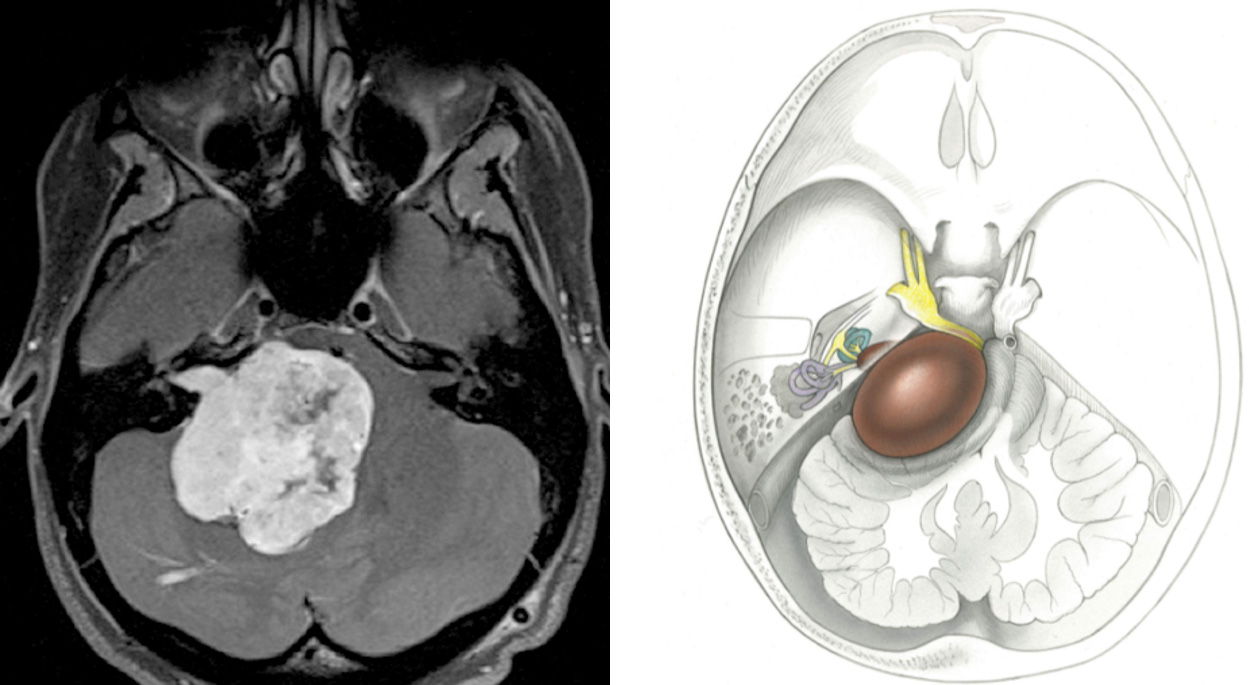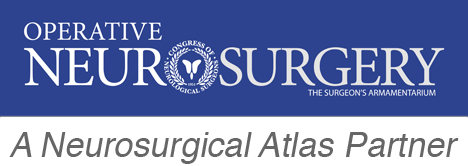概述
An acoustic neuroma, orvestibular schwannoma, is a tumor that arises from the covering of the nerve responsible for hearing and balance as it passes from the inner ear to your brain. These tumors are noncancerous and generally grow slowly. Thus,小聽神經瘤might not require treatment. With larger tumors, patients might experience hearing loss, tinnitus or ringing in the ear, and unsteadiness or balance problems. Treatment options for acoustic neuroma include observation, surgical removal, and radiation.
What Is an Acoustic Neuroma?
An acoustic neuroma, also called vestibular schwannoma, is a noncancerous and generally slow-growing tumor that arises from the Schwann cell covering of the vestibulocochlear nerve. This nerve is responsible for hearing and balance as it passes from the inner ear to your brain. The tumor expands from the bony auditory canal and into the base of the skull, forming a distinctive pear-shaped tumor. While it does not typically infiltrate and invade the brain, it might push on other nerves or the brainstem, resulting in symptoms.

圖1:患者用大聽神經瘤(左)和大聽神經瘤按壓周圍腦結構(右)的繪製大腦MRI。
有什麼症狀?
聽神經瘤常引起任何症狀,尤其是如果腫瘤較小。較大的腫瘤,但是,可以壓縮周圍而引起的症狀,如聽力下降,耳鳴或耳,和不穩定或平衡問題振鈴結構。在90%的患者中看到的最早的症狀是與腫瘤上的一側聽到減少(有時尤其明顯在電話上說話時),可以被誤認為附帶年齡的正常變化。
If the facial nerve neighboring the vestibulocochlear nerve becomes involved, there can be weakness of the facial muscles, which makes it difficult to blink or smile. In addition, the increase in pressure inside the head can lead to headache, weakness, and confusion. In extreme cases, a large tumor can compress the trigeminal nerve (which provides sensation to the face), resulting in facial numbness. Such large tumors can also invade the brainstem, where vital functions such as breathing and heart rate are coordinated.
What Are the Causes?
In most cases, there is no well-defined cause of acoustic neuromas. Some studies have linked such tumors with prolonged exposure to loud noise, but this link has not been confirmed. There might also be a link to radiation exposure over one’s lifetime. In a small number of cases, acoustic neuromas are part of a rare genetic condition called neurofibromatosis type 2, caused by a malfunctioning gene on chromosome 22. Such cases would usually involve acoustic tumors on both sides of the head.
常見的是如何呢?
Recent reports stated that acoustic neuromas are becoming more common, but this phenomenon might be due to advances in imaging that enable physicians to detect more tumors earlier than ever. Current estimates indicate that acoustic neuromas occur in about 2 in every 100,000 people. They are diagnosed most commonly in patients who are between 30 and 60 years old.
How Is It Diagnosed?
聽神經瘤是由大腦的核磁共振成像(MRI)掃描診斷。該試驗通常與對比材料,釓,其有助於精確地確定腫瘤進行。聽力圖應與MRI雙耳進行一起測試聽力功能。最後,有些患者可能會經曆一個聽性腦幹反應測試。這個測試測量沿神經向大腦的電脈衝。通過這個神經傳導中的缺陷可能表明腫瘤的存在。
What Are the Treatment Options?
Acoustic neuroma treatment varies depending on several factors, including your overall health and tumor size. There are currently 3 main acoustic neuroma treatment options from which patients and physicians can choose:
觀察
The most conservative approach to an acoustic neuroma is observation. Because these tumors are not cancerous and grow very slowly, some patients choose to simply follow the tumor over a period of time if they are older or have very a small tumor that was discovered incidentally. If this option is chosen, the patient must undergo an MRI scan on a yearly basis for at least 5 years to make sure that the tumor is not growing.
Surgery
Surgery for an acoustic neuroma is good for patients with a larger tumor that is pushing on the brainstem. This method can remove the tumor either completely or partially, depending on the decision reached by the surgeon and the patient. Partial removal will decrease the tumor’s size and reduce or eliminate any symptoms associated with it. This option, however, requires the patient to undergo regular MRI follow-up to ensure that the tumor is not growing.
完全切除腫瘤是可能的,優選的情況較多。在試圖徹底清除,外科醫生的目標是保持麵部和聽覺神經兩者。兩個神經整個手術過程中電監測,並且如果檢測到任何缺陷,外科醫生會立即通知。手術後,大多數病人在醫院3〜5天,並有4〜6周在家恢複。許多患者並不需要這麼多的時間來達到健康,他們做了手術前的同一水平。
目前有3種手術方式,患者和醫生應該討論其中哪些是最好遵循:
- Translabyrinthine—this approach is used when hearing preservation is not required (that is, when the patient has already lost hearing in the affected ear). The incision is located behind the ear, and the surgeon drills through the mastoid bone, exposing the tumor from below. This approach allows the surgeon to see the facial nerve early and ensure its preservation. In this procedure, a small amount of fat is taken from the abdomen and used to pack the surgical area to prevent any leakage of brain fluid (cerebrospinal fluid) after surgery.
- 乙狀竇後枕下或使用 - 這個方法時聽力保留是一個主要的目標,或者是外科醫生的偏好。該切口在耳後幾厘米,腫瘤從其背麵暴露出來。這種方法還可以使麵神經的識別和保存。
- Middle fossa- 此方法也可用於保護聽力。切口是在頭部,耳朵上方幾厘米的頂部部分,並且提供從頂部開始的腫瘤的暴露。

Figure 2: Removal of an acoustic neuroma via the retrosigmoid approach involves making a cut behind the ear (left) and carefully peeling the tumor off of the vestibulocochlear nerve (right).
Possible complications of acoustic neuroma surgery include infection, leak of cerebrospinal fluid out of the nose or incision site, stroke, hearing loss, temporary paralysis of the face muscles, dizziness or vertigo, and headaches. One might also experience eye dryness, which can be treated with eye drops. Hearing loss, paralysis of the facial muscles, and tinnitus or ringing in the ear might occur because of the manipulation of these nerves during surgery. Although these symptoms are most often temporary, depending on the extent of damage to these nerves and the amount of involvement of the nerves with the tumor, these side effects can become permanent.
Most patients experience vertigo, or a feeling of the room spinning around them, for about 1 week or more after the surgery. Headaches are also a common complaint after surgery. These symptoms will pass within a few weeks, but a small number of patients might experience them on a chronic basis; these patients can be treated with a variety of medications to relieve their discomfort. The occurrence of these complications is lowest with smaller tumors.
Radiation
Radiation is another treatment option for acoustic neuromas. There are 2 ways to deliver this treatment. One way is radiosurgery, which involves one large dose of radiation delivered to the tumor. The other way is fractionated radiotherapy, in which multiple small doses of radiation are delivered over a period of several weeks. This procedure is noninvasive and requires no hospital stay for recovery.
在放射外科,數以百計的輻射的小,濃縮的光束的旨在使用所述3個當前可用的放射外科手術設備(伽瑪刀,射波刀,或諾瓦利斯)的1的腫瘤。該過程本身需要30到50分鍾,並且患者被放置在立體定向井架上的程序,其穩定所述頭部,並允許治療小組到機器校準到病人的頭部和腫瘤的日子。
The patients who undergo fractionated radiotherapy receive smaller doses of radiation over several visits. Each visit takes only 5 to 15 minutes, and the patient is able to go about his or her business before and after the visit. Fractionated radiotherapy poses less risk to the facial and hearing nerves.
需要注意的是放療不切除腫瘤是很重要的。它可能在某些情況下,會導致腫瘤縮小。輻射的主要目標是從停止生長腫瘤。其結果是,病人必須返回MRI掃描,每年來檢查任何新的增長點。
放射治療可能出現的並發症包括麵部麻木和無力,以及聽力損失。這些副作用通常是暫時的,幾個星期的過程中通過。隨著分割放療,可能需要長達18個月的治療,以徹底阻止腫瘤的生長。然而,放射治療是無創,不攜帶感染,腦脊液漏,以及與手術相關的中風的風險。此外,患者通常有手術後無眩暈或頭痛。
What Is the Recovery Outlook?
大多數患者接受手術切除的coustic neuroma experience near-complete removal of the tumor. However, in a small number of people, the tumor can reappear; it is important that such a reappearance be closely followed or treated with radiation. After surgery or radiation, the patient should undergo regular follow-up MRI scans and appointments with her or his surgeon to ensure that the tumor does not return. Any resulting complications should be treated with medication and/or physical therapy as needed.
Resources
詞彙表
Vestibulocochlear nerve—the 8th pair of cranial nerves, which consists of sensory fibers responsible for balance and hearing
Facial nerve—the 7th pair of cranial nerves, which supplies motor fibers to facial muscles
Schwann cell—形成神經的長度周圍的覆蓋絕緣細胞
腦脊髓流體圍繞腦和脊髓清晰流暢
Tinnitus—a feeling of ringing or buzzing in one or both ears
貢獻者:Gina Watanabe BS






